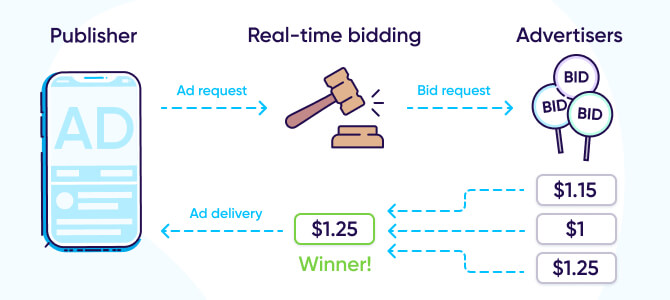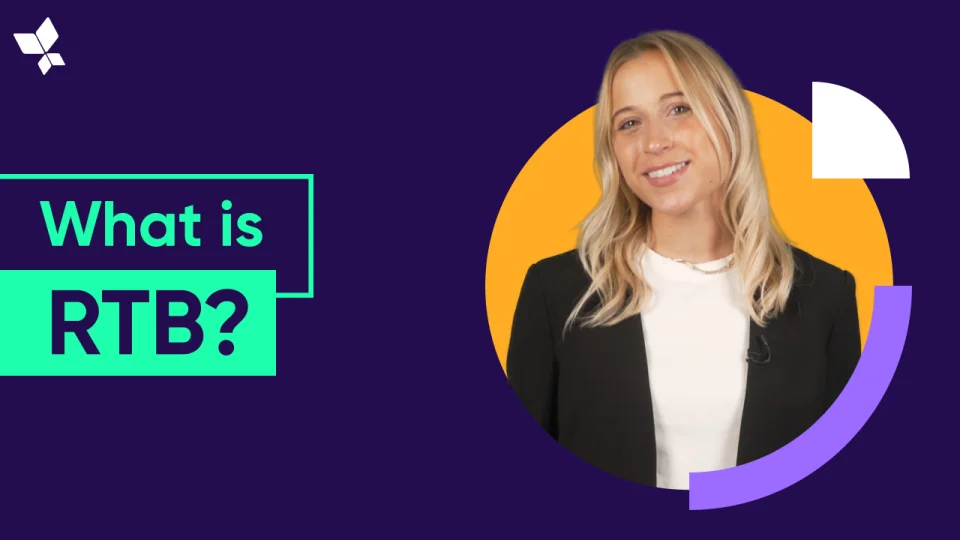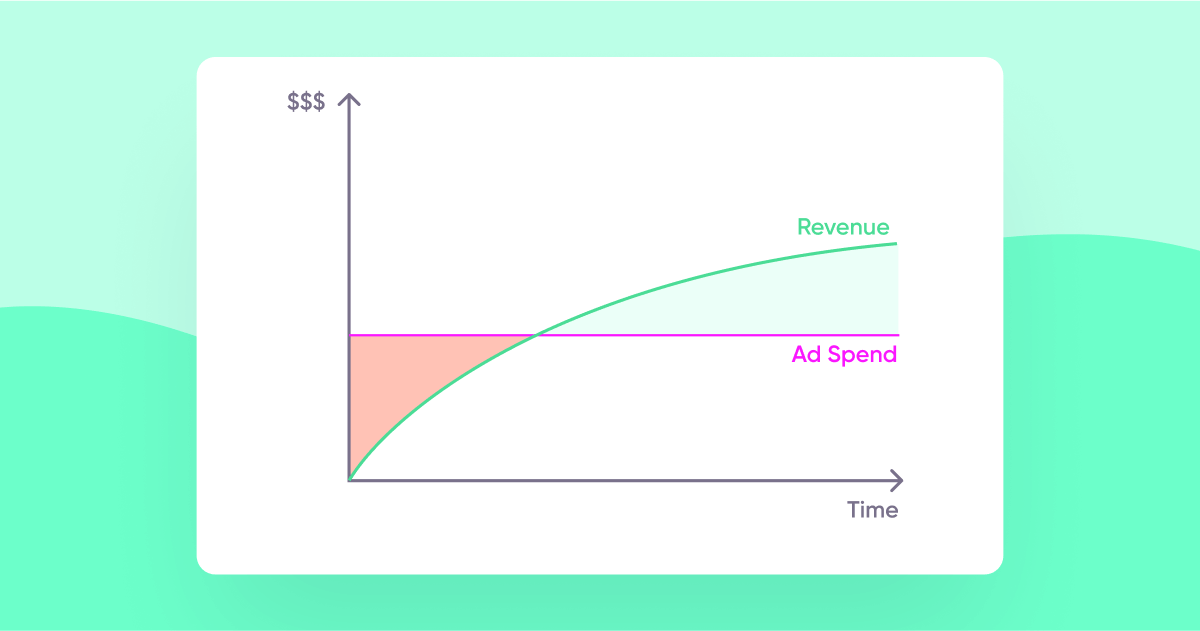
Real-time bidding (RTB)
The process of employing demand-side platforms (DSPs) to bid automatically for ad impressions. The bidding happens in real time, “in the fraction of a second between the time a prospect lands on a page, and that page has fully loaded.”
What is real-time bidding?
It is an integral part of programmatic advertising, which is the buying and selling of ads in real time and on a per-impression basis. Bidding is done in an instant auction facilitated by DSPs and SSPs.
Do you know that moment during a mobile game where you are served an ad in-between game levels? It’s precisely at that moment that a mobile SSP ran an auction, and all of the advertisers interested in showing you (the player) an ad bid via DSPs for the impression. It takes just a split second for the highest bidder to be chosen and their ad to be served to you.
How does real-time bidding work?

Multiple advertisers bid on a single impression of a publisher’s inventory in real time, and then the highest bid, i.e., the winning ad, is shown to the user.
RTB allows advertisers to target and focus on the inventory most relevant to a consumer. It is exactly why when you read your favorite clean-eating blog, the ads you are served are usually for your local organic market. Or how about that mommy blog and its stroller ads?
Targeting your users in this way yields better conversion rates, which, in turn, yields better ROIs and higher eCPMs. Additionally, advertisers can adjust their campaign budgets in real time to optimize campaign performance with RTB. And WOW — are campaigns performing?! Research shows that the global real-time bidding market will grow “from USD 6.6 billion in 2019 to USD 27.2 billion by 2024.”
What are the pros and cons of real-time bidding?
RTB technology facilitates advertisers and publishers in buying and selling their inventory programmatically. Considering this technological enhancement of buying and selling of ad space, it is evident that RTB comes with some advantages.
However, there are also some disadvantages to employing this method that marketers should bear in mind.
The top 2 pros of RTB
There are a couple of advantages to employing RTB and programmatic advertising for both advertisers and publishers. However, the precision targeting RTB grants is the top benefit for those who choose this method.
1 – Precise audience targeting: With RTB, advertisers bid on ad space meant for a specific audience at any time. This targeting allows advertisers to reach the exact customers who want what they offer.

2 – Improved inventory targeting: RTB also grants publishers the control to set the floor price for their inventory. Additionally, publishers can change that floor price at any time to maximize their revenue.
Advertisers targeting their audience and publishers targeting and controlling their floor price is how each side of the programmatic advertising ecosystem can use RTB to its advantage.
The top 2 cons of RTB
While programmatic advertising and real-time bidding are the future of digital advertising, there are some drawbacks. One disadvantage for both advertisers and publishers (albeit differently) is the lack of human control, which can result in brand inconsistencies and ad placement issues.
1 – Lack of control over context: Because the human piece has been removed from programmatic advertising, there is potential for ad match mistakes that can leave an advertiser looking bad.
For example, you read your morning news on your phone, and there has been a devastating plane crash. Below the article is an ad for a travel site running a special on plane tickets. Relying only on algorithms, keywords, and RTB to place ads can sometimes result in unfortunate ad placements that can call advertisers’ taste into question.
2 – Lack of control over content: On the other hand, for publishers, programmatically selling your precious impressions means that you give up control as to who and what is served on your page. What happens if you serve unwanted ads/advertisers to your users? Will that stop them or others from wanting to visit your page in the future?
Advertisers and publishers can be negatively affected by mismatched ads, which is an unfortunate yet unsurprising consequence of the missing human touch in programmatic advertising and real-time bidding.
Real-time bidding vs. header bidding
Header bidding, or advanced bidding/pre-bidding, is a programmatic approach to selling advertising space in real time. With this type of bidding, publishers can auction inventory to multiple ad exchanges that bid for the highest price.
Though they sound like the same thing, the differences between header bidding and RTB are nuanced and require consideration. The first thing to consider is that header bidding is a subset of RTB (so, it makes sense that they’re easy to confuse).
Traditional real-time bidding has each ad exchange performing its own auction one at a time. In contrast, header bidding allows all of the ad exchanges to bid on multiple auctions simultaneously by employing RTB.
Header bidding is like the 2.0 version of programmatic ad buying. In the 2.0 version, publishers can offer their inventory to multiple ad exchanges, which avails premium ad space to advertisers. Basically, the souped-up version has fewer limitations when it comes to audience and reach than just the traditional RTB version.
Publishers benefit the most from this method. Research shows that among the 1,000 most popular internet sites that use programmatic advertising, 79.2% used header bidding.
Real-time bidding vs. programmatic buying
Programmatic buying is the non-auction model in programmatic advertising. Unlike RTB, programmatic direct takes place when publishers sell their ad space directly to advertisers for a negotiated price and for a fixed amount of time.
Programmatic buying makes the most sense for “premium display formats, like full-page takeovers. For such a high-cost investment, it only makes sense for advertisers to require guaranteed measures of knowing exactly who is seeing their ad, where, and in what context.”
Key takeaways
RTB allows both advertisers and publishers to have a significant degree of control over their ad spend. And while RTB and the programmatic advertising ecosystem offer many positives, there are also some drawbacks.
So, in a nutshell, here is everything you need to remember about real-time bidding and the programmatic advertising ecosystem:
- RTB is the process of employing demand-side platforms to bid automatically for ad impressions in real time — and is an integral part of programmatic advertising.
- One major advantage of RTB is that publishers and advertisers can segment and optimize audiences and reach in real time.
- However, taking people out of media buying can result in untimely or insensitive ad mismatches and place publisher and advertiser brands in jeopardy with their audiences.
- With header bidding, publishers can offer their inventory to multiple ad exchanges, availing premium ad space to advertisers. It’s basically the souped-up version of RTB (and a subset of it as well).
- Programmatic buying is the safer, non-auction method of programmatic advertising for premium ads.


